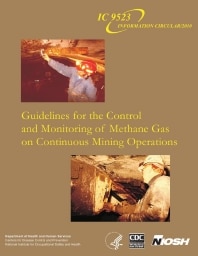Mining Product: Guidelines for the Control and Monitoring of Methane Gas on Continuous Mining Operations
Original creation date: April 2010
Authors: CD Taylor, JE Chilton, GV Goodman
NIOSHTIC2 Number: 20036964
Pittsburgh, PA: U.S. Department of Health and Human Services, Public Health Service, Centers for Disease Control and Prevention, National Institute for Occupational Safety and Health, DHHS (NIOSH) Publication No. 2010-141, Report of Investigations 9523, 2010 Apr; :1-75
The results from this NIOSH research program demonstrate how existing and new engineering controls can be used to reduce face methane levels. The sampling methods that were investigated can provide better ways to measure methane levels near the front of the continuous mining machine. In this report several practical guidelines are recommended for controlling and monitoring methane levels in the face areas of underground coal mines. Most of the recommendations were based on studies conducted in the NIOSH ventilation test gallery.

NIOSHTIC2 Number: 20036964
Pittsburgh, PA: U.S. Department of Health and Human Services, Public Health Service, Centers for Disease Control and Prevention, National Institute for Occupational Safety and Health, DHHS (NIOSH) Publication No. 2010-141, Report of Investigations 9523, 2010 Apr; :1-75